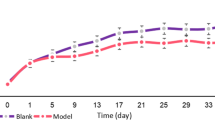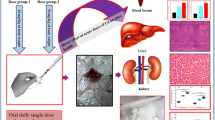Abstract
Chronic ingestion of environmental heavy metals such as lead (Pb) and cadmium (Cd) causes various well-documented pathologies in specific target organs following their intestinal absorption and subsequent accumulation. However, little is known about the direct impact of the non-absorbed heavy metals on the small intestine and the colon homeostasis. The aim of our study was to compare the specific bioaccumulation and retention of Cd and Pb and their effect on the essential metal balance in primary organs, with those occurring specifically in the gastrointestinal tract of mice. Various doses of Cd (5, 20 and 100 mg l−1) and Pb (100 and 500 mg l−1) chloride salts were provided in drinking water for subchronic to chronic exposures (4, 8 and 12 weeks). In contrast to a clear dose- and time-dependent accumulation in target organs, results showed that intestines are poor accumulators for Cd and Pb. Notwithstanding, changes in gene expression of representative intestinal markers revealed that the transport-, oxidative- and inflammatory status of the gut epithelium of the duodenum, ileum and colon were specifically affected by both heavy metal species. Additionally, in vivo comet assay used to evaluate the impact of heavy metals on DNA damage showed clear genotoxic activities of Cd, on both the upper and distal parts of the gastrointestinal tract. Altogether, these results outline the resilience of the gut which balances the various effects of chronic Cd and Pb in the intestinal mucosa. Collectively, it provides useful information for the risk assessment of heavy metals in gut homeostasis and further disease’s susceptibility.





Similar content being viewed by others
References
Burlinson B, Tice RR, Speit G, Agurell E, Brendler-Schwaab SY, Collins AR, Escobar P, Honma M, Kumaravel TS, Nakajima M, Sasaki YF, Thybaud V, Uno Y, Vasquez M, Hartmann A (2007) Fourth international workgroup on genotoxicity testing: results of the in vivo comet assay workgroup. Mutat Res 627:31–35
Cardin GB, Mantha M, Jumarie C (2009) Resistance to cadmium as a function of Caco-2 cell differentiation: role of reactive oxygen species in cadmium- but not zinc-induced adaptation mechanisms. Biometals 22:753–769
Cherayil BJ, Ellenbogen S, Shanmugam NN (2011) Iron and intestinal immunity. Curr Opin Gastroenterol 27:523–528
Claudio L, Lee T, Wolff MS, Wetmur JG (1997) A murine model of genetic susceptibility to lead bioaccumulation. Fundam Appl Toxicol 35:84–90
Dublineau I, Grandcolas L, Grison S, Baudelin C, Paquet F, Voisin P, Aigueperse J, Gourmelon P (2007) Modifications of inflammatory pathways in rat intestine following chronic ingestion of depleted uranium. Toxicol Sci 98:458–468
DuPont AW, DuPont HL (2011) The intestinal microbiota and chronic disorders of the gut. Nat Rev Gastroenterol Hepatol 8:523–531
Elsenhans B, Strugala GJ, Schäfer SG (1997) Small-intestinal absorption of cadmium and the significance of mucosal metallothionein. Hum Exp Toxicol 16:429–434
Fazeli M, Hassanzadeh P, Alaei S (2011) Cadmium chloride exhibits a profound toxic effect on bacterial microflora of the mice gastrointestinal tract. Hum Exp Toxicol 30:152–159
Goon D, Klaassen CD (1989) Dosage-dependent absorption of cadmium in the rat intestine measured in situ. Toxicol Appl Pharmacol 100:41–50
Hemdan NY, Emmrich F, Sack U, Wichmann G, Lehmann J, Adham K, Lehmann I (2006) The in vitro immune modulation by cadmium depends on the way of cell activation. Toxicology 222:37–45
Horiguchi H, Oguma E, Kayama F (2011) Cadmium induces anemia through interdependent progress of hemolysis, body iron accumulation, and insufficient erythropoietin production in rats. Toxicol Sci 122:198–210
Iavicoli I, Carelli G, Stanek EJ 3rd, Castellino N, Calabrese EJ (2006) Below background levels of blood lead impact cytokine levels in male and female mice. Toxicol Appl Pharmacol 210:94–99
James HM, Hilburn ME, Blair JA (1985) Effects of meals and meal times on uptake of lead from the gastrointestinal tract in humans. Hum Toxicol 4:401–407
Lafuente A, González-Carracedol A, Esquifino AI (2004) Differential effects of cadmium on blood lymphocyte subsets. Biometals 17:451–456
Lerner A (2007) Aluminum is a potential environmental factor for Crohn’s disease induction: extended hypothesis. Ann N Y Acad Sci 1107:329–345
Lind Y, Glynn AW (1997) The involvement of metallothionein in the intestinal absorption of cadmium in mice. Toxicol Lett 91:179–187
Liu J, Qu W, Kadiiska MB (2009) Role of oxidative stress in cadmium toxicity and carcinogenesis. Toxicol Appl Pharmacol 238:209–214
Lukacinova A, Racz O, Lovasova E, Nistiar F (2011) Effect of lifetime low dose exposure to heavy metals on selected serum proteins of Wistar rats during three subsequent generations. Ecotoxicol Environ Saf 74:1747–1755
Maslowski KM, Vieira AT, Ng A, Kranich J, Sierro F, Yu D, Schilter HC, Rolph MS, Mackay F, Artis D, Xavier RJ, Teixeira MM, Mackay CR (2009) Regulation of inflammatory responses by gut microbiota and chemoattractant receptor GPR43. Nature 461:1282–1286
Min KS, Ueda H, Kihara T, Tanaka K (2008) Increased hepatic accumulation of ingested Cd is associated with upregulation of several intestinal transporters in mice fed diets deficient in essential metals. Toxicol Sci 106:284–289
Nieto-Fernandez FE, Ruiz A, Ntukogu N, Nodimelle L, Pryor SC (2006) Short term lead exposure induces a stress-like response in adult mice. Med Sci Monit 12:BR325–BR329
Park JD, Cherrington NJ, Klaassen CD (2002) Intestinal absorption of cadmium is associated with divalent metal transporter 1 in rats. Toxicol Sci 68:288–294
Round JL, Mazmanian SK (2009) The gut microbiota shapes intestinal immune responses during health and disease. Nat Rev Immunol 9:313–323
Shaikh ZA, Smith JC (1980) Metabolism of ingested cadmium in humans. In: Holmstedt B, Lauwerys R, Mecier M, Roberfroid M (eds) Mechanisms of toxicity and hazard evaluation. Elsevier, Amsterdam, pp 569–574
Singh NP, McCoy MT, Tice RR, Schneider EL (1988) A simple technique for quantitation of low levels of DNA damage in individual cells. Exp Cell Res 175:184–191
Thijssen S, Cuypers A, Maringwa J, Smeets K, Horemans N, Lambrichts I, Van Kerkhove E (2007a) Low cadmium exposure triggers a biphasic oxidative stress response in mice kidneys. Toxicology 236:29–41
Thijssen S, Maringwa J, Faes C, Lambrichts I, Van Kerkhove E (2007b) Chronic exposure of mice to environmentally relevant, low doses of cadmium leads to early renal damage, not predicted by blood or urine cadmium levels. Toxicology 229:145–156
Zalups RK, Ahmad S (2003) Molecular handling of cadmium in transporting epithelia. Toxicol Appl Pharmacol 186:163–188
Acknowledgments
The authors thank Michèle Patin and Gaëtane Dannel for technical assistance and the “Service de biochimie automatisée” of the CHRU of Lille, headed by Pr Thierry Brousseau for handling some of biochemical assays. We are also grateful to Annick and Etienne Dekhil.
Conflict of interest
The authors declare no conflict of interest.
Funding
The present study was done in the context of a french multidisciplinary project called “Mélodie-Reve” (Métaux lourds, désordres immunitaires et écotoxicologie intestinale—(bio)-Remédiation in vivo, standing for Heavy metals, immune disorders and intestinal Ecotoxicology—in vivo (bio)-remediation) supported by the National Research Agency (ANR-09-CES-016).
Author information
Authors and Affiliations
Corresponding author
Electronic supplementary material
Below is the link to the electronic supplementary material.
Rights and permissions
About this article
Cite this article
Breton, J., Le Clère, K., Daniel, C. et al. Chronic ingestion of cadmium and lead alters the bioavailability of essential and heavy metals, gene expression pathways and genotoxicity in mouse intestine. Arch Toxicol 87, 1787–1795 (2013). https://doi.org/10.1007/s00204-013-1032-6
Received:
Accepted:
Published:
Issue Date:
DOI: https://doi.org/10.1007/s00204-013-1032-6




